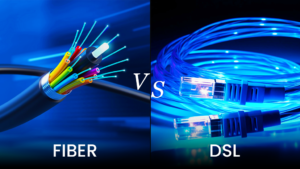Choosing the right internet connection in 2025 is no small task. With increasing demands for high-speed, reliable internet for work, streaming, gaming, and smart home connectivity, the decision often boils down to two primary contenders: fiber-optic and cable internet.
What is Fiber-Optic Internet?
Fiber-optic internet uses thin glass or plastic cables to transmit data as light signals. This cutting-edge technology offers some of the fastest and most reliable internet speeds available.

Pros of Fiber-Optic Internet:
- Exceptional Value: While fiber plans might seem more expensive upfront, the benefits you receive—lightning-fast speeds, reliability, and future-proof technology—deliver unmatched value over time.
- Blazing Speeds: Fiber can deliver symmetrical upload and download speeds up to 1 Gbps or higher, making it ideal for modern internet demands.
- Low Latency: Reduced lag ensures smooth online gaming, video conferencing, and real-time applications.
- Reliability: Fiber is less susceptible to interference from weather or electromagnetic signals, ensuring consistent performance even during peak hours.
Cons of Fiber-Optic Internet:
- Availability: Fiber coverage is still expanding and may not be accessible in all areas.
What is Cable Internet?
Cable internet relies on coaxial cables, the same technology used for cable TV, to deliver internet services. It’s widely available and often offers competitive speeds.
Pros of Cable Internet:
- Widespread Accessibility: Cable is accessible in most urban and suburban areas, making it a reliable choice for many households.
- Adequate Speeds: For general use like streaming, browsing, and casual gaming, cable’s speeds (up to 1 Gbps) can meet many needs.
Cons of Cable Internet:
- Shared Bandwidth: Performance can drop during peak usage times since bandwidth is shared among nearby users.
- Higher Latency: Compared to fiber, cable can have higher lag, which impacts real-time activities like gaming.
- Susceptible to Interference: Coaxial cables are more prone to disruptions from weather and signal interference.
Head-to-Head Comparison: Fiber vs. Cable
| Feature | Fiber-Optic | Cable |
| Speed | Symmetrical; up to 10 Gbps | Asymmetrical; up to 1 Gbps |
| Latency | Very Low | Moderate |
| Reliability | Highly reliable | Prone to interference |
| Availability | Expanding but limited | Widely available |
| Cost Efficiency | Better long-term value | Lower upfront costs |
| Best For | Heavy users, gamers, smart homes |

Fiber is the right choice if:
- You want a reliable connection that adds value to your home or business by supporting seamless streaming, gaming, and smart home systems.
- You work from home or run a business and need consistent high-speed internet.
- You’re looking for an investment in future-ready internet that saves money in the long run by reducing downtime and improving efficiency.
Who Should Choose Cable Internet?
Cable is a great option if:
- You’re a light-to-moderate internet user who streams, browses, and games occasionally.
- You’re looking for an internet solution with lower initial costs.
- Fiber isn’t available in your area yet.
The Future of Internet Connectivity
As we move further into 2025, the gap between fiber and cable is expected to widen. Fiber-optic infrastructure continues to expand, offering unmatched speed, reliability, and scalability that outshine the limitations of traditional cable. However, cable remains a reliable and accessible solution for users with basic internet needs.
If you’re still unsure about which option suits your needs, consider reaching out to experts like Punchcard. With their insights, you can make an informed decision tailored to your lifestyle and internet requirements.




